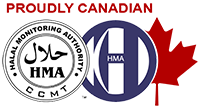Halal monitoring authority
ABOUT
HMA
NEED FOR MONITORING AUTHORITY
For many years individual Imams and Ulama received complaints from the Muslim community and in particular individuals from the Halal industry that many things within the industry were not being observed in accordance to the Shariah. In March of 2004 the Jami’yyatul Ulama Canada (CCMT) therefore decided to appoint a team of members whose task was to observe and discover what is really going on within the industry. The team managed to inspect 13 poultry abattoirs, 4 meat abattoira, 7 further processing plants and numerous other manufacturing plants and retailers.
Throughout these inspections, which were documented, the team discovered many areas of concern in majority of the places that were visited and steps were taken to try and rectify the problems. The team got in contact with the existing Halal certifying boards who were providing some of the visited abattoirs and facilities with a ‘Halal Certificate’ in order to bring to their attention the flaws they had discovered in their system throughout their investigation and to discuss how to rectify them, but these meetings were of no avail. While one of the bodies expressed that they have no intention of changing their procedures, the representative of the other certifying body simply told us, “Who authorized you to carry out these investigations?” With the existence of these flaws the reliability of our meats and non meat products being Halal was put to question, thus having a negative impact on our worship and prayers and on the behavior of our children.
In order to overcome this unfortunate situation, the Jami’yyatul Ulama Canada (CCMT) decided that it was necessary to form a uniform verification and certification body to monitor our Halal supplies. To implement, facilitate and create a clear-cut reliable certification procedure and to establish a unified central certification board, and thus to take us forward into the pursuit of our Islamic duty of facilitating our moral and obligatory right, a steering committee was formed by the Jami’yyatul Ulama Canada (CCMT) to serve this cause and help the Muslim community.
PROBLEMS IN THE INDUSTRY
Some of the many problems we discovered during our inspections were: Slaughter men at abattoirs not reciting the Tasmiyah during the slaughter . Recitation of the name of Allah at the time of slaughter is a condition for the animal to be Halal. However this condition was not being fulfilled by majority of the slaughter men we had interviewed. Instead they were either; chewing gum during the slaughter talking to their co-workers simply not reciting the tasmiyah because they were unaware of its importance reciting the tasmiyah only once at the beginning of the slaughter thinking that it is sufficient for the entire kill reciting the tasmiyah only upon one bird in every ten Non-Muslims slaughtering at various abattoirs, rendering the meat Haram. Minimum amount of required veins not cut resulting in the animal being Haram. There are four arteries within the animal that are designated to be cut at the time of slaughter; 1) The Throat 2) The Oesophagus 3) The two Jugular Veins.
Unfortunately, many slaughter men pay no attention towards which arteries and how many of them are being cut during the slaughter due to either sheer ignorance or the speed of the line being too fast. Unmonitored stunning methods prior to slaughter. There are many types of stunning techniques: The captive bolt pistol (used for cows/cattle). Electric stunning (used for sheep). Electrified water bath (used for poultry). According to the Ulama (religious scholars) stunning which causes death prior to slaughter is not accepted in Islam. Usage of rotating mechanical blades for slaughter which does not serve the requirements of Halal slaughter.
The team found in a renowned poultry abattoir that rotating mechanical blades were being used to slaughter the birds. A slaughter man would recite bismillah when switching on the machinery and would then go stand by the blade and recite bismillah at his own pace. By the time he would complete one recital at least ten chickens had passed by on the line (the speed of the line was 200 chickens per minute) Contamination issue. (mixing of halal with non-halal). The team also discovered poultry being processed on un-sanitized lines thus causing non zabiha leftovers to be mixed with the zabiha meat on the machinery. Retailers do not know if they are being cheated. The team found that various retail and butcher store owners could not verify if the meat that is supplied to them is genuine halal. They stated that they merely take the word of the suppliers and it can be possible that they are cheated in believing that the products supplied to them are halal. Meat coming from abroad.
The appointed inspection team also discovered that large amounts of meat were imported from foreign countries. Local plants cannot guarantee the meat that had been imported was slaughtered in accordance to halal guidelines. NON-PROTEIN The following are some of the problems discovered in non meat products: non halal ingredients used without being declared use of machinery and procedures that do not comply with halal requirements packaging made from non halal substances In short, these and many other issues had to be addressed and therefore the HMA was formed.
- Contact HMA
- 416-731-2247
- 1-855-462-1462
- 1825 Markham Road, Suite # 211, Scarborough Ontario, M1B 4Z9
- info@hmacanada.org
- Share this page
- Send us an Email
Featured companies and partners

































